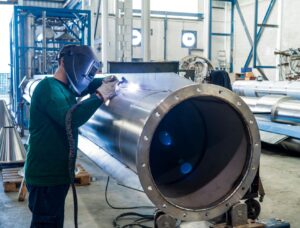Welding is one of the most critical processes in shipbuilding and marine engineering, ensuring the structural integrity and longevity of vessels. From cargo ships and submarines to offshore oil rigs and naval fleets, precision welding techniques are required to withstand harsh marine environments, extreme pressure, and corrosive seawater. Discover the critical role of welding in shipbuilding and marine engineering. Learn how real-time weld monitoring, automation, and precision techniques ensure the durability and safety of ships.
With the advancements in welding technology, tools like Mecaweld’s welding cameras provide real-time monitoring to ensure high-quality welds, reduce defects, and improve efficiency in ship construction and repairs.
Importance of Welding in Shipbuilding
Ensuring Structural Integrity
Ships are subjected to intense mechanical stress, water pressure, and environmental conditions. A single welding defect can compromise the strength of the entire vessel.
Welding’s Role in Ship Construction:
- Joins large metal plates to form the hull and deck.
- Strengthens internal structures like bulkheads and reinforcements.
- Ensures leak-proof seams in submerged components.
How Mecaweld Helps:
- Real-time weld monitoring detects weld defects like cracks, porosity, and incomplete fusion before they cause structural failures
Enhancing Corrosion Resistance
Marine environments are highly corrosive, and improper welds can lead to premature rusting and structural damage.
Solution: Advanced welding techniques like TIG and laser welding create smooth, durable welds resistant to corrosion.
How Mecaweld Helps: Welding cameras provide precision monitoring, ensuring uniform weld penetration to prevent weak spots that accelerate corrosion.
Common Welding Techniques in Shipbuilding
Shielded Metal Arc Welding (SMAW) – Traditional and Reliable
Used for structural welding in shipbuilding due to its adaptability to varied environments (including outdoor and underwater conditions).
- Advantages: Works well on thick steel and withstands wind and moisture.
- Challenges: Requires post-weld cleaning due to slag formation.
Gas Metal Arc Welding (GMAW/MIG) – High-Speed Welding
Ideal for large-scale welding projects like assembling ship panels.
- Advantages: Fast, efficient, and produces clean welds with minimal slag.
- Challenges: Not ideal for outdoor work due to wind-sensitive shielding gas.
Flux-Cored Arc Welding (FCAW) – Best for Thick Metal Welding
Preferred for heavy-duty ship construction due to deep penetration capabilities.
- Advantages: High deposition rate, works in harsh environments.
- Challenges: More fume production, requiring better ventilation.
Tungsten Inert Gas Welding (GTAW/TIG) – High-Precision Welding
Used for critical welds requiring exceptional weld quality (e.g., fuel tanks, pressure vessels).
- Advantages: Produces clean, precise welds.
- Challenges: Slower process, requiring high skill.
How Mecaweld Helps: Welding cameras provide real-time analysis to maintain weld quality and penetration depth.
Challenges in Marine Welding
Welding in marine environments means facing humidity, salt exposure, and underwater conditions.
Solution: Using underwater welding techniques like wet SMAW and dry hyperbaric welding.
Industry 4.0 and Smart Welding Systems
Preventing Weld Defects
Common defects in ship welding include:
- Porosity (trapped gases weakening the weld).
- Cracks (caused by thermal stress).
- Incomplete fusion (due to incorrect heat input).
- Solution: Real-time welding cameras detect and correct defects instantly, preventing costly rework.
Ensuring Compliance with International Standards
Ships must meet strict safety regulations set by:
- International Maritime Organization (IMO)
- American Bureau of Shipping (ABS)
- Lloyd’s Register (LR)
How Mecaweld Helps: Automated weld monitoring systems ensure compliance with safety standards by providing consistent, high-quality welds.
The Role of Welding in Ship Repairs and Maintenance
Hull Repairs and Reinforcements
Ships endure constant wear and tear, requiring frequent weld repairs.
Solution: On-site welding monitoring helps ensure repairs meet safety standards.
Offshore Rig and Pipeline Maintenance
Oil rigs and pipelines require corrosion-resistant welds to prevent leaks.
Solution: Weld cameras monitor deep-sea welding operations, ensuring strong, watertight seals.
Future of Welding in Shipbuilding
Automation and Robotic Welding
Shipyards are increasingly using robotic welding arms for precision and efficiency.
Benefits:
- Faster production speeds with reduced labor costs.
- Minimizes human error, improving overall weld consistency.
- Improves worker safety by reducing exposure to hazardous conditions
AI and Smart Welding Technologies
Artificial intelligence is revolutionizing marine welding with:
- AI-powered defect detection before final inspections.
- Predictive maintenance algorithms to prevent equipment failures.
Conclusion
Welding is the backbone of shipbuilding and marine engineering, ensuring the durability, strength, and safety of vessels operating in harsh environments. With advancements in welding automation and real-time monitoring, shipbuilders can improve efficiency, compliance, and long-term reliability.
Enhance your marine welding processes with Mecaweld’s advanced welding cameras. Contact us today to learn how real-time weld monitoring can optimize shipbuilding and repair operations!



